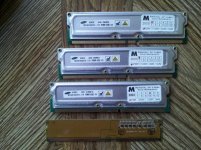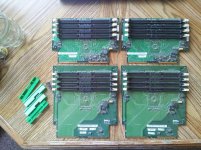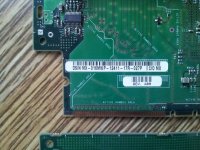xjas
Experienced Member
I have:
2GB in 8x256MB matched PC-800 ECC with 4 terminators
1GB in 2x256 & 1x512MB PC-4200 non-ECC with one terminator
All Samsung.
I don't know much about how RAMBUS evolved, but see the pics for part #s, etc. These are NOT interchangeable, the ECC & non-ECC have different keyings.
Also, 4 RAM expansion boards from Dell Precision 530 workstations (one of each board per system.) These fit the ECC RAM.





Offering them up here before they hit Ebay. I'd love to get $20 out of all this, but RDRAM prices are all over the map and I can't figure out if it's actually valuable or not. Make me an offer.
2GB in 8x256MB matched PC-800 ECC with 4 terminators
1GB in 2x256 & 1x512MB PC-4200 non-ECC with one terminator
All Samsung.
I don't know much about how RAMBUS evolved, but see the pics for part #s, etc. These are NOT interchangeable, the ECC & non-ECC have different keyings.
Also, 4 RAM expansion boards from Dell Precision 530 workstations (one of each board per system.) These fit the ECC RAM.





Offering them up here before they hit Ebay. I'd love to get $20 out of all this, but RDRAM prices are all over the map and I can't figure out if it's actually valuable or not. Make me an offer.
